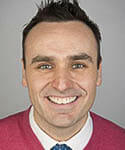A study performed by Kevin Finn, associate professor and chair of health sciences, and colleagues Kathleen FitzPatrick and Zi Yan showed that freshmen enrolled in an introductory anatomy and physiology course, where lecture and lab instruction were integrated, earned better grades, on average, and had few incidents of withdrawal than their peers who took separate lecture and lab classes.
“We saw some improvement in performance, based on the observation that a lower number of students received C-minus, D or F grades, or withdrew from the course, in the integrated model,” Finn said in an interview. “Both students and instructors reported high levels of satisfaction with the new model, particularly in the ability to immediately apply theory in a hands-on manner in a smaller class size, with greater student-faculty interaction.”
Anatomy and physiology is a two-semester course required of all freshmen health sciences majors. Students in the traditional model attended biweekly lectures of 75 minutes and weekly labs of 150 minutes. Students in the integrated model met twice a week for 110 minutes, receiving both lecture and lab instruction each class.
The study showed that students enrolled in the integrated semester recorded the lowest rate of unsatisfactory grades in the last four years of the program. As a result, fewer students fell behind in their studies or were required to take makeup classes at additional expense, a key to student retention and satisfaction, Finn said.
Finn and his team found similarly positive results for the integrated approach for students enrolled in the department’s upper-level courses in biomechanics and microbiology for the health professions. As a result, the department has transitioned all of its lecture and laboratory courses to the integrated model.
Follow-up research is planned with students after they complete their anatomy and physiology II class this spring.
“We want to talk to those anatomy and physiology students and tease out some more information,” Finn said.




